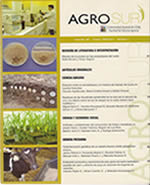Fertilización fosforada en el ciclo de vida, producción de forraje y semilla de trébol carretilla (Medicago hispida Gaertn) en Camacani Puno
Contenido principal del artículo
Resumen
Las praderas del altiplano del Perú son base de la alimentación del ganado, el trébol carretilla es una leguminosa naturalizada, crece entre cultivos agrícolas, produce excelente forraje y aporta nitrógeno; sin embargo, no es valorada, más aún es arrancada por ser considerada una maleza. Se realizó un estudio a 3842 m s.n.m. para evaluar la influencia de la fertilización fosforada sobre la duración del ciclo de vida, rendimiento de forraje, producción de semilla y la calidad de las semillas de trébol carretilla. Se evaluaron cinco tratamientos experimentales (0, 40, 60, 80 y 100 kg ha-1 de P2O5), bajo un diseño estadístico bloque completo al azar. Las plantas de trébol luego de la emergencia alcanzaron la madurez de fruto en 164 días con las dosis de 80 y 100 kg ha-1 de P2O5. Con las fertilizaciones de 80 y 100 kg ha-1 de P2O5 también se obtuvo los mayores rendimientos de materia verde (7.116 y 6.351 kg ha-1) y materia seca total (1.914 y 1.658 kg ha-1). La fertilización fosforada no influyó sobre la altura de planta (p ≥ 0,05); la dosis de 80 kg ha-1 de P2O5 influyó en el mayor rendimiento de semilla (120 kg ha-1), en el peso de 100 semillas (0,42 g) y en el poder germinativo de las semillas de trébol carretilla.

